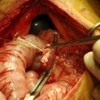A Dog Model of Pancreaticojejunostomy Without Duct-to-Mucosa Anastomosis
Abstract
Context Various anastomosis techniques have been introduced for the safe pancreaticoenterostomy. Objective In the present study, we developed an experimental animal model for simple pancreaticojejunostomy and evaluated the feasibility, safety, and efficacy of this technique. Animals Ten dogs were studied. Intervention The dogs underwent the simple approximation (“docking”) method for pancreaticojejunostomy and were re-explored on the 30th post-operative day. Main outcome measure After excision of the remnant pancreas with the jejunal segment of the pancreaticojejunostomy, the degrees of fibrosis in the remnant pancreas were analyzed according to the patency of the pancreaticojejunostomy. Results There were no mortalities and clinically significant complications. The patency of pancreaticojejunostomy remained in six cases and was obliterated in four cases. It was noted that obliterated pancreaticojejunostomy accompanied cases with more dilated pancreatic ducts (3.1±0.4 mm vs. 5.5±0.6 mm, P=0.008). The grade of pancreatic fibrosis was significantly correlated with the obliterated pancreaticojejunostomy (P=0.038) and the size change of the remnant pancreatic duct (P=0.040). Conclusions The suggested simple pancreaticojejunostomy method is easy and shows no evidence of significant pancreatic fistula. However, the potential risk of dysfunction in the remnant pancreas limits its possible clinical applications. The meticulous duct-to-mucosa pancreaticojejunostomy is highly preferred to manage the remnant pancreas following pancreaticoduodenectomy.Downloads
References
Cameron JL, Pitt HA, Yeo CJ, Lillemoe KD, Kaufman HS, Coleman J. One hundred and forty-five consecutive pancreaticoduodenectomies without mortality. Ann Surg 1993; 217: 430-435; discussion 435-438.
Trede M, Schwall G, Saeger HD. Survival after pancreatoduodenectomy. 118 consecutive resections without an operative mortality. Ann Surg 1990; 211: 447-458.
Willett CG, Lewandrowski K, Warshaw AL, Efird J, Compton CC. Resection margins in carcinoma of the head of the pancreas. Implications for radiation therapy. Ann Surg 1993; 217: 144-148.
Kang CM, Kim KS, Choi JS, Lee WJ, Kim BR. Personal experience of pancreas reconstruction following pancreaticoduodenectomy. ANZ J Surg 2006; 76: 339-342.
Suzuki Y, Fujino Y, Tanioka Y, Hiraoka K, Takada M, Ajiki T et al. Selection of pancreaticojejunostomy techniques according to pancreatic texture and duct size. Arch Surg 2002; 137: 1044-1047; discussion 1048.
Yeo CJ, Cameron JL, Lillemoe KD, Sauter PK, Coleman J, Sohn TA et al. Does prophylactic octreotide decrease the rates of pancreatic fistula and other complications after pancreaticoduodenectomy? Results of a prospective randomized placebo-controlled trial. Ann Surg 2000; 232: 419-429.
DeOliveira ML, Winter JM, Schafer M, Cunningham SC, Cameron JL, Yeo CJ et al. Assessment of complications after pancreatic surgery: A novel grading system applied to 633 patients undergoing pancreaticoduodenectomy. Ann Surg 2006; 244: 931-937; discussion 937-939.
Lin JW, Cameron JL, Yeo CJ, Riall TS, Lillemoe KD. Risk factors and outcomes in postpancreaticoduodenectomy pancreaticocutaneous fistula. J Gastrointest Surg 2004; 8: 951-959.
Yang YM, Tian XD, Zhuang Y, Wang WM, Wan YL, Huang YT. Risk factors of pancreatic leakage after pancreaticoduodenectomy. World J Gastroenterol 2005; 11: 2456-2461.
Newman SJ, Steiner JM, Woosley K, Williams DA, Barton L. Histologic assessment and grading of the exocrine pancreas in the dog. J Vet Diagn Invest 2006; 18: 115-118.
Kuroda Y, Tanioka Y, Matsumoto S, Kim Y, Fujita H, Ajiki T et al. A new technique for pancreaticogastrointestinal anastomosis without suturing the pancreatic parenchyma. J Am Coll Surg 1995; 181: 311-314.
Greene BS, Loubeau JM, Peoples JB, Elliott DW. Are pancreatoenteric anastomoses improved by duct-to-mucosa sutures? Am J Surg 1991; 161: 45-49; discussion 49-50.
Murakami Y, Uemura K, Hayashidani Y, Sudo T, Hashimoto Y, Nakagawa N et al. No mortality after 150 consecutive pancreatoduodenctomies with duct-to-mucosa pancreatico¬gastrostomy. J Surg Oncol 2008; 97: 205-209.
Kim JH, Yoo BM, Kim WH. Which method should we select for pancreatic anastomosis after pancreaticoduodenectomy? World J Surg 2009; 33: 326-332.
Marcus SG, Cohen H, Ranson JH. Optimal management of the pancreatic remnant after pancreaticoduodenectomy. Ann Surg 1995; 221: 635-645; discussion 645-638.
Fromm D, Schwarz K. Ligation of the pancreatic duct during difficult operative circumstances. J Am Coll Surg 2003; 197: 943-948.
Amano H, Takada T, Ammori BJ, Yasuda H, Yoshida M, Uchida T et al. Pancreatic duct patency after pancreaticogastrostomy: long-term follow-up study. Hepatogastroenterology 1998; 45: 2382-2387.
Hyodo M, Nagai H. Pancreatogastrostomy (PG) after pancreatoduodenectomy with or without duct-to-mucosa anastomosis for the small pancreatic duct: short- and long-term results. Hepatogastroenterology 2000; 47: 1138-1141.
Bai MD, Rong LQ, Wang LC, Xu H, Fan RF, Wang P et al. Experimental study on operative methods of pancreaticojejunostomy with reference to anastomotic patency and postoperative pancreatic exocrine function. World J Gastroenterol 2008; 14: 441-447.
Fujino Y, Suzuki Y, Matsumoto I, Sakai T, Ajiki T, Ueda T et al. Long-term assessments after pancreaticoduodenectomy with pancreatic duct invagination anastomosis. Surg Today 2007; 37: 860-866.

Copyright (c) 2014 Sung Hoon Choi, Jun Jeong Choi, Chang Moo Kang, Ho Kyoung Hwang, Woo Jung Lee

This work is licensed under a Creative Commons Attribution 4.0 International License.
As a member of Publisher International Linking Association, PILA, iMedPub Group’s JOP follows the Creative Commons Attribution License and Scholars Open Access publishing policies. Journal of the Pancreas is the Council Contributor Member of Council of Science Editors (CSE) and following the CSE slogan Education, Ethics, and Evidence for Editors.